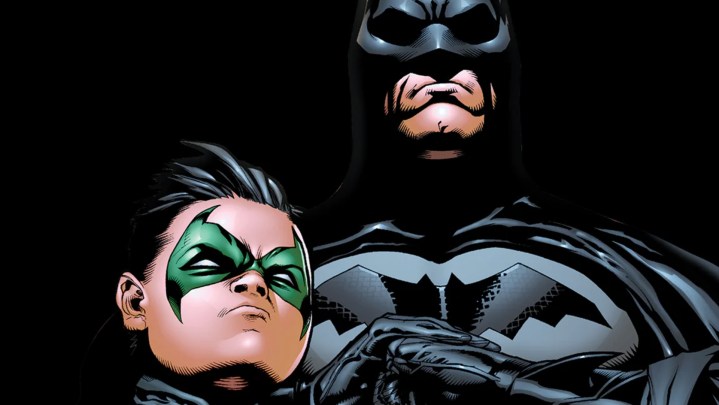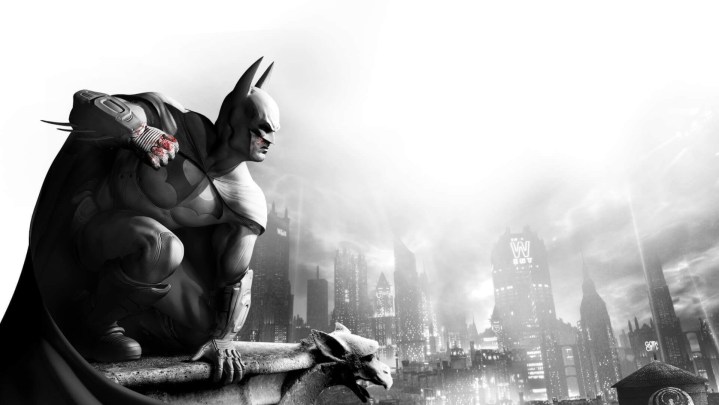James Gunn and Peter Safran, co-CEOs of DC Studios, recently unveiled the initial slate for the DCU’s upcoming first phase, er, chapter, and with it came the answer to Batman’s interconnected cinematic future in the form of an upcoming film called The Brave and the Bold. This announcement, titled “Chapter I: Gods and Monsters,” revealed that Matt Reeves and Robert Pattinson’s crime-noir rendition of the superhero would fall under the DC Elseworlds banner, and will include the upcoming sequel The Batman Part II.
But Gunn also made a point to involve the DCU and Elseworlds labels in the video game industry, which poses an exciting potential proposition for how this new Dark Knight’s world could be expanded on more than one front. The Brave and the Bold is set to introduce an established Bruce Wayne in this universe — along with Damian Wayne as his Robin — which paves the way for plenty of prequel storytelling opportunities for this Batman in the gaming world.
An exciting and established canon to play with

It’s not much of a secret at this point that audiences are generally “over” the concept of the origin story, at least when it comes to established and beloved characters like Batman. No one’s exactly clamoring to see Bruce’s parents get gunned down in an alley again or for Martha Wayne’s pearl necklace to fall in slow-motion anymore, which is something Reeves did well to avoid altogether with last year’s critically praised The Batman.
But what Gunn and Safran aim to do with The Brave and the Bold is go in a different direction, at least theatrically. This Batman looks to be leaning more into the fantastical elements of the DCU and not have him be the sole superhero of his world like in Reeves’ blossoming trilogy and Christopher Nolan’s work before him. Just as well, this version looks to be even more “established,” with this Caped Crusader already set with Damian Wayne as the Boy Wonder.
This makes The Brave and the Bold already poised to adapt the comic book source material in a more literal sense, but how much is not clear until a synopsis or the movie’s release sheds more light. Regardless, Batman will be well into his crimefighting career here, with his biological son potentially being the fourth to adopt the mantle of Robin.

On top of finally getting the chance to see the Dynamic Duo’s theatrical reputation redeemed, the source material — DC legend Grant Morrison’s sprawling run on the character, which Gunn has already cited — is just as exciting. But whether Nightwing, Red Hood, Oracle, Batgirl, Red Robin, or any combination of those extended Bat-family characters exist at this point in the DCU, the timeline could give developers around 10 years of continuity to play with in a series of video games.
While there would undoubtedly be some level of “red tape” in terms of playing nicely within the DCU sandbox, such a premise offered by this timeline should give ample room for creativity. With a hypothetical decade of canon at a studio’s disposal, a lot can happen to Batman and his supporting cast that wouldn’t feel like required experiences for those that simply stick to the movies and TV shows.
And given that part of Batman’s fame is with his iconic rogues’ gallery, exploring this future corner of the DCU in gaming could shed light on villains that might not be big enough to feature in cinematic ventures. Just as much, it could provide additional context to existing ones.
The Lucasfilm multimedia format

As far as massive multimedia entertainment franchises go, there are few that match or exceed Lucasfilm’s Star Wars IP. It’s been a pop culture staple for over 40 years, and Star Wars’ expansive universe makes for great drama across a variety of subgenres.
And while not a 1:1 comparison with the forthcoming DCU, Lucasfilm’s multimedia approach to the mammoth sci-fi/fantasy franchise could work on a smaller, more specific scale with The Brave and the Bold‘s Batman and his corner of a wider universe. Respawn Entertainment’s Star Wars Jedi: Fallen Order — and, by extension, the upcoming sequel Star Wars Jedi: Survivor — could be seen as an outline for this.
While Cal Kestis and company’s journeys across the galaxy may have fallen under the universe-wide reign of the Empire that the Skywalker Sagadramatically established, their stories were (and likely will be) mostly isolated. These are tales that don’t complicate the greater Star Wars canon, but they simultaneously operate within well-known stories and contexts stemming from the mainline films and enrich the continuity for those interested in playing them.
It’s effectively a win-win situation when it comes to storytelling, even though in The Brave and the Bold‘s scenario, games would be centered around the same set of characters. Even so, and as decades’ worth of DC Comics series have proven, there’s plenty of room for one-off and longer-form stories considering that the likes of Batman, Detective Comics, Legends of the Dark Knight, and more comic titles have all run along the same time frame.
And that goes for Gunn’s source material of choice for The Brave and the Bold, as Morrison’s time on the character overall was like the Dark Knight’s personal Odyssey in scope, with both Morrison and writers like Paul Dini telling stories completely separate from what was going on with the Black Glove, Bruce traveling through time, and a race to — literally — save Catwoman’s heart from Hush.
Batman’s next step after Rocksteady’s Arkham series

The elephant in the room, of course, would be the looming shadow that Rocksteady’s novel Arkham series casts over the concept of Batman in gaming. Those games — and WB Games Montréal’s Arkham Origins prequel to a lesser, but admirable degree — arguably achieved a level of acclaim for Batman that Nolan did with The Dark Knight Trilogy, saving the hero from years of mediocre-to-poorly received installments.
And while gaming’s latest depiction of Gotham City with Gotham Knights unfortunately underwhelmed, there’s enough room for a potential series of Brave and the Bold spinoff games to be great endeavors on their own terms. There will surely be a lot of legwork to such a project, as storytelling needs to be built around engaging gameplay first and foremost.
The Arkham series succeeded in telling compelling Batman stories that paid homage to the DC Animated Universe’s incarnation of the brooding hero, and it set a high bar for the Dark Knight’s cathartic martial arts prowess.
But since the late Kevin Conroy’s passing and Suicide Squad: Kill the Justice League possibly being that version of the character’s last bout, there needs to be a next step beyond the “Arkhamverse.” However, the comparisons to Arkham will be inevitable and shouldn’t stop studios from giving video games another go, and the DCU and Brave and the Bold provide the perfect excuse to do so.
Many likely thought that no gritty recreation of Batman was necessary after the acclaim of Nolan’s trilogy, but The Batman nonetheless received strong critical praise and became a box-office hit because of it’s street-level realism. A video game follow-up can surely follow suit, using a different story and actors, but maintaining the essential appeal of the Dark Knight — foreboding and mysterious — that made the Arkhamverse such a hit to begin with.
DC Studios’ The Brave and the Bold doesn’t currently have a release date, but Gunn’s Superman: Legacy is set to premiere on July 11, 2025, with Reeves’ The Batman Part II to follow on October 3, 2025.
Editors’ Recommendations
Services Marketplace – Listings, Bookings & Reviews
